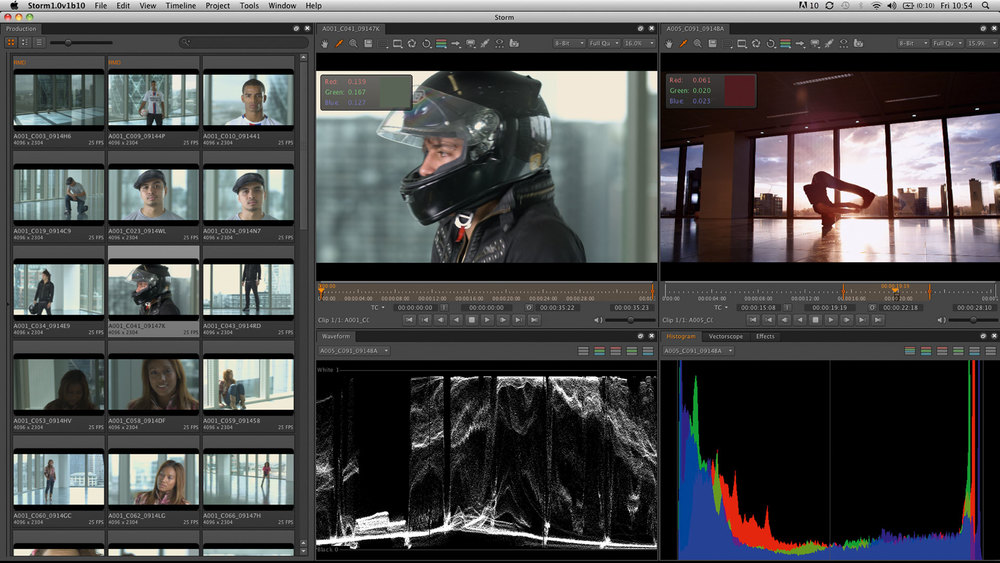
A STORM Settles Over Set And Post
Posted on May 5, 2011 by Alex Fice
While we look at the concept of STORM, Director of Photography, Editor and VFX man Jim Geduldick explains where the product fits in to his workflow
Checking exposure with STORMFor Digital Image Technicians (DITs) STORM is a godsend. It has a lot to do with the features on offer, from the manipulation of r3d files to an editor, to a grading tool, to a waveform monitor to a Metadata controller. But perhaps even more importantly it also gives the DIT an identity. Ever since digital cinematography started and RED cameras in particular were introduced the DIT has had to work hard for any status he or she has attained.
STORM comes from the magicians who make the Nuke compositor. The Foundry saw that the world of digital cameras was creating a huge amount of data that needed housekeeping and began to see how their skillset could be adopted for the preparation of digitally shot files, initially only from RED cameras. Chris Steele from The Foundry sets the scene, “We began to see how important Metadata was going to be. We were used to how important it was but traditionally it was a kind of add-on. But with cameras like RED you’ve got to have Metadata. But there is potentially a load more Metadata that can be generated that needs looking after. We saw that as being almost as important as the video and audio.”
A trend towards to multi-tasking was also identified, something that could explain the identity crisis some DITs were having as their job bridged multi-discipline skillsets. This of course was more prevalent in the burgeoning indie market where RED is and was feted. There was also a sliding of traditionally post related jobs nearer the set. All this evolution has created STORM.
How I Use STORM – Jim GeduIdick
I have been on the steering team for helping develop STORM with the Foundry since its initial inception last year. I have also used it on a few film/music videos already.
STORM is not just geared for DIT or Digi loaders, its much more then that and the possibilities are quite broad. A DIT can use this tool to not only help the DP or Director set looks and verify but to also start helping with the offline as well. In some cases STORM would be used by an editor or assistant for the offline but what I have done or what people may like to use STORM for in this case is when on set being able to set up trim passes (edits or colour decisions) then send the trimmed R3Ds to a colourist or LAB for processing.
By doing this you are not compressing any data and you are also only sending just what would be needed. In this way by the time the LAB or colourist gets the dailies drives he has already been working on trimmed R3Ds or via XML
The DIT role encompasses so much more these days and a lot of people have a wrong or pre-conceived notion of what a DIT is or does. I am not a DIT but at times when I am doing VFX supervision or RED supervising on set I know the technical side just as well as the creative so I don’t mind getting my hands dirty on setting up the pipeline.
DITs do so much more then just manage files. A lot of my friends who are some of the top DITs help set looks with the DP and Director, in some cases being asked to ‘best light’ shots with a on-set grade to then be baked as is for dailies.
The DIT also has to know the camera and file system better then anyone on set – it’s his/her job to know the pipeline and technicalities of the files coming off the sensor and the workings of the camera itself. The collaboration from pre-production to post is going the way of having a lot more decisions being made on or near set that ripple throughout production to finish.
The way STORM deals with Metadata is I think the tip of a very large iceberg. Metadata is key – it relates to everything from extensible searches in our applications to those Meta fields then being populated for delivery methods.
So an example would be, I am on set with STORM setting Meta tags for myself to edit or do VFX later to quite possibly pass off to another vendor. Think of those Meta tags also being used by Google or some other search engine or iTunes to get a remarkably infinite search of media for delivery and distribution.
Controlling the colour/look management on set can require a lot of budget and the people who understand the pipeline. I think STORM having features like this for LUT support for example is only going to enable people to actually make sure they are shooting things correctly and acquiring the images they intend to get.
STORM does have tools in place with preset looks and effects that allow you to audition this and then build from it. You can then have that travel along with a RMD (sidecar file) which can head off to the colourist or VFX house.
STORM has so much potential which is one of the reasons why I got involved in helping the Foundry out with it from a user standpoint. The fact that it is being built from the ground up and by a group of people and scientists who understand not only the user base but the technical aspect is something I wish I could say about other tools I use daily from other big name companies.
My workflow with STORM has a few avenues:
• I can set looks and offline edits while I or another DP is shooting.
• A DIT or assistant can tag clips and create timelines, send off XML with markers to an editor /colourist and have the dailies uploaded to secure FTP and be in iPads and laptops after a lunch break.
• I can do a R3D trim pass for my VFX (out to Nuke) or other VFX houses by retaining all RAW data string out clips with base corrections on them without sending out Terabytes of data over FTP or local drive.
• The ability to conform from offline to online back to the original source (2k,4k etc) and round tripping to FCP and Avid is huge. Other applications that support FCP XML like Premiere Pro and scripts to After Effects are even more reason that conforming with STORM is pretty simple. You can’t forget it is also multitrack capable.
I can’t comment on what STORM will have in the future but if you look at Nuke for example and the Foundry toolset in place already it is pretty easy to say that possible tools will trickle down over time as requests and workflows are better understood by STORM users/clients.








